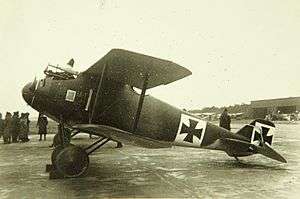LFG Roland D.I
| D.I | |
|---|---|
 | |
| Role | Fighter |
| National origin | Germany |
| Manufacturer | LFG, Pfalz |
| Designer | Dipl Ing Tantzen |
| First flight | July 1916 |
| Primary user | Luftstreitkräfte |
| Number built | ca. 20 |
The LFG Roland D.I was a fighter aircraft produced in Germany during World War I.[1] It was a single-seat aircraft based originally on the Roland C.II two-seat reconnaissance type. It shared its predecessor's unusual design feature of having a deep fuselage that completely filled the interplane gap, but in comparison, the fuselage was much sleeker. While the C.II's appearance had earned the Walfisch ("Whale"), the D.I became known as the Haifisch ("Shark").[2] The I-struts that had been used to brace the C.II's wing were replaced by more conventional struts. Other changes to the wing included the removal of stagger from the design and the introduction of slight sweepback.[2]
The prototype flew in July 1916 and was accepted by the Idflieg for military service. Production was interrupted, however, by a fire at the factory after only around twenty machines had been built. When production eventually resumed, it was of the improved Roland D.II.
Variants
- LFG Roland D.I
- The standard fighter.
- Pfalz D.I
- 20 aircraft licence-built by Pfalz Flugzeugwerke, s/n: 1680-1699/16, from February 1917 renamed Roland D.I (Pfal).[3]
- LFG WD
- Two float seaplane version first flown 29 June 1917 and tested at Warnemünde in July. It was found wanting both in its flight characteristics and the view forward and downwards. The latter criticism was frequently made of the D.I and its descendants, visibility blocked by engine radiators and the lower wing.modifications were made, but further official testing in September lead to the refusal of a production order. Modified yet again, the single example ended with the seaplane single-seat fighter school. It is sometimes referred to as the LFG W, though this name is also used for a LFG floatplane version of the Albatros C.Ia.[4][5]
Operators
Specifications
General characteristics
- Crew: One pilot
- Length: 6.80 m (22 ft 4 in)
- Wingspan: 8.90 m (29 ft 2 in)
- Height: 2.90 m (29 ft 6 in)
- Wing area: 23.0 m2 (247 ft2)
- Empty weight: 700 kg (1,540 lb)
- Gross weight: 932 kg (2,050 lb)
- Powerplant: 1 × Mercedes D.III, 120 kW (160 hp)
Performance
- Maximum speed: 180 km/h (112 mph)
- Cruising speed: 157 km/h (98 mph)
- Endurance: 1 hours 30 min
- Service ceiling: 4,500 m (14,800 ft)
- Rate of climb: 2.8 m/s (540 ft/min)
Armament
- 2 × fixed, forward-firing 7.92 mm LMG 08/15 machine guns
Notes
References
| Wikimedia Commons has media related to Roland aircraft. |
- Green, Peter; Thetford, Owen (1970). German Aircraft of the First World War. London: Putnam. ISBN 0-85177-809-7.
- Green, William; Swanborough, Gordon (1994). The Complete Book of Fighters. Godalming, UK: Salamander Books. ISBN 1-85833-777-1.
- Taylor, Michael J. H. (1989). Jane's Encyclopedia of Aviation. London: Studio Editions.
- World Aircraft Information Files. London: Bright Star Publishing.
- Уголок неба